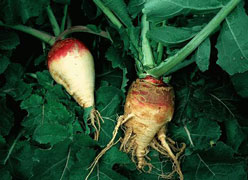


Home
Flowers &
Indoor Plants
Fruits & Nuts
Ornamentals
Vegetables
Special Topics
Resources
Glossary

|
Turnip Brassica rapa (Brass-ih-cah rah-pah ) |
 |
What about it? Turnips are members of the Mustard family. They are relatives of cabbage, rutabagas, and radishes. They are simple to grow but certainly not the most popular vegetable in the United States today. What is it used for? Turnips are grown for their edible taproot that can be eaten raw or cooked into soups and stews. Turnip greens are also edible and provide nutrients like iron, potassium, calcium, and vitamin A. Where does it grow? How do we grow it?Turnips need cool weather and loose soil. It takes them 2 months to mature so you can probably get 2 turnip harvests in one season. The spring crop is not the best quality but the fall crop should be sweeter and more tender. Insects are less of a problem in the fall as well. A heat wave during the growing season will cause your turnips to become bitter. Frost will not bother your turnips but be sure to remove the plants before the ground freezes. Thin the stand when the plants are 4 inches high. Give them 3 inches of space. What are its primary problems? The only major problem to look out for is the cabbage root maggot, although common scab has also been reported. How do we propagate it? Plant turnip seeds directly into beds as soon as you can work the soil. Plant them 1/2 inch deep. Space them according to their purpose, if you are growing turnips for their greens they can be planted in dense clusters, if you are growing them for their roots you may want to plant them at least 2-3 inches apart. This will save you work when it comes time to thin the patch. How do we harvest and store it? Turnips will grow to a diameter of 3 inches. Harvest size is about lemon-size. Dig them out of the soil with a spade. They will keep for several months in the refrigerator. Turnip greens can be harvested at any time.
© Copyright, Department of Horticulture, Cornell University. |